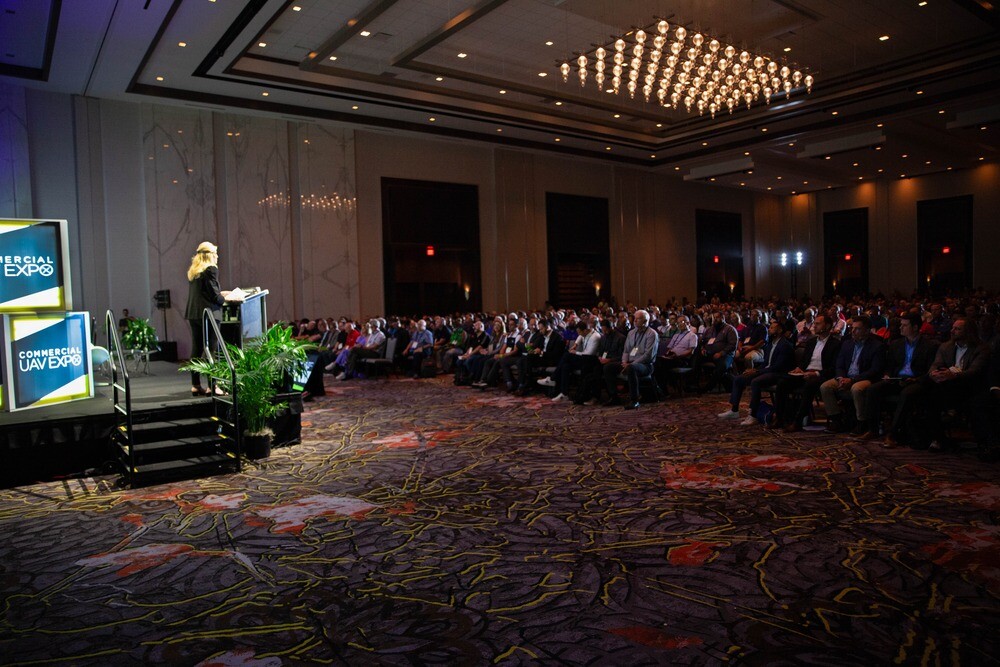Last week in Las Vegas, the annual Commercial UAV Expo was held at Caesar’s Forum, bringing together companies and professionals from the commercial drone industry encompassing a variety of different use cases. The show included an outdoor flying demonstration where a handful of companies showed off their drones’ capabilities, the “pitch the press” competition, a packed exhibit hall floor and three days of speaker and panel sessions covering every corner of the commercial UAV industry, from public safety to taxi services, and of course surveying and construction.
It’s a wide-ranging conference, but given the historical overlap between the UAV community and surveyors, as well as the technology’s growing influence on construction sites, it’s no surprise that the geospatial and AEC communities made up a significant portion of the audience. With that in mind, here are three takeaways from three days speaking to those in the industry and listening to experts and thought leaders throughout the conference program.
Public trust is front of mind
One of the major themes of this year’s show was that commercial drones are no longer a fringe technology that is being used by just the most innovative professionals and companies, but a tool that is becoming ubiquitous in so many industries. That’s a great trend in the bigger picture given all of the benefits we know drones provide like opening up new projects and use cases, making surveying and inspections of certain areas safer, counteracting industry workforce shortages, and more. However, it also means there are more UAVs flying around public spaces, which the general public is noticing.
This was one of the themes I heard throughout my week in Las Vegas, with people talking about how garnering public trust is the next step that needs to be taken. From my perspective, this rang particularly true for industries like surveying and utilities inspection. In fact, there was a session featuring professionals in the utility inspection space, and one speaker – Teena Deering – talked about her work in San Diego and instances of residents shooting down drones because they thought they were spying. While of course nobody should just be shooting BB guns (and in some cases, real guns), it’s an understandable impulse to someone who probably doesn’t know that these drones are used for inspections.

My reaction to that, and a lot of the other conversations I heard and partook in through the week, was the public outreach is highly necessary for these fields. The use of drones for things like surveying and inspections certainly shouldn’t slow down as their value is undeniable at this point, but it’s also incumbent to keep the public apprised of when drones may be flying around their residence. Gaining that public trust will take careful and conscious work, and will never really stop, but it’s crucial if this industry is going to take that next step of which we truly seem to be on the precipice.
Delivery and Taxis are coming
For the last few years, the Advanced Air Mobility space – i.e. drone delivery and drone taxis – was a theoretical one that people spoke of as something coming, but not here yet. Those discussions have seemingly started to shift based on the week in Las Vegas. There was a two-part summit around AAM, and the exhibit hall floor was filled with companies in the delivery and/or taxi space. The former is already starting to take off in some parts of the world, and the latter is now being thought of less theoretically than before.
At first glance this doesn’t seem to matter much to the geospatial industries, but there is a fair amount of overlap. For one thing, that means more drones in the air, likely leading to more regulations to track, not to mention the aforementioned growing need for public outreach. On top of that, though, positioning is going to be crucial for these uncrewed tools. It’s something that came across with a conversation with Brad Schmidt of Applanix, a company that has long provided positioning technology for the surveying industry. They’re recognizing the imminence of drone delivery – and eventually taxi services – and I suspect we’re going to see other similar companies take the same step over the next year or so.
Educating the Future Workforce
Just as we’re seeing in industries like construction and surveying, the commercial drone space is one that is growing in value but has an aging and/or simply small workforce relatively speaking. There is a great need to foster the next generation of professionals to take the industry to the prominence it has the potential to reach, but as with the public outreach it will take intentional and serious groundwork to get there. We saw some of that on display through the week.
Walking through the exhibit hall, there were multiple universities with booths to talk to prospective professionals about training programs, and many attendees who were looking for ways to break into the space. There were also companies who, at least as part of their work, encouraged children as young as grade school to start learning the technology. While UAVs will be able to do some jobs that humans can’t safely complete, the technology is meant as an aid to humans and not a replacement, and fortunately the industry seems to recognize that need for the next generation coming about as quickly as possible.






